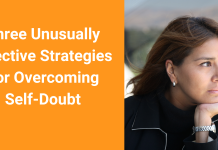
How can you transform your work environment from frustrating and lifeless to engaging and inspiring?
Being a leader means keeping track of valuable data, from sales, to profits, and customer satisfaction. It is, after all, an important part of your job to know where things are working and where they’re falling flat. But have you ever followed the numbers when it comes to employee values? Or measured the data of employee behaviour? Then you may be missing out on some crucial feedback.
Chris Edmonds is a speaker, executive consultant, the founder and CEO of the Purposeful Culture Group. He is a top 100 leadership speaker, and was featured at South by Southwest as a presenter. He's the author of The Culture Engine: A Framework for Driving Results, Inspiring Your Employees, and Transforming Your Workplace. I recently interviewed Chris for the LEADx Podcast, where we discussed the measurable results of a happier work culture. (The interview below has been lightly edited for space and clarity.)
Kevin Kruse: You say: “The foundation of high performance and values alignment is an organizational constitution.” What do you mean by that?
Chris Edmonds: What's really cool is that as soon as I say “organizational constitution,” I get heads nodding, even around the globe. As I'm doing keynotes on this work, I get head nodding, so we can go back to the Magna Carta to get a look at that, but the idea of a constitution is pretty well known. I don't have to do a whole lot of explanation, but after saying an “organizational constitution”, I’ll hear “Well, what do you mean? I know that if we have a constitution, it means we have rules and we're supposed to abide by them.” I said, “That's exactly where we're going.”
The thing that an organizational constitution does—and this is really my mantra—I tell leaders all the time, “Fabulous investment of time and energy and managing performance? Good for you. I know that you are incented and rewarded to do that, but that's only half the leader's job.” Of course, most of the leaders will go, “That's only half the job? There must be something I'm missing.” Well, yes, and the other half of the job is managing the quality of the workplace. It's about how people are treating each other.
What an organizational constitution does is it formalizes rules for civility and sanity. It really does. The big kickoff is a ‘servant purpose,’ which is a purpose statement beyond making money. It's whom you are serving and why that’s inspiring and potentially meaningful to your staff.
The second piece is ‘values and behaviors,’ which we'll talk a little bit more about, but it's really literally defining what a good citizen does, how a good citizen treats peers, bosses, customers and vendors. We are going to create liberating rules but they're rules nonetheless that say, “I'm going to treat people civilly. I'm going to validate people's ideas.”
Those behaviors then guide the treatment of others. Then of course, we have to include the formalizing of performance expectations in the form of strategies and goals. What a constitution does is it validates the strategies and goals. There's no question we have to perform well, but it creates—almost on an equal footing—that we're actually going to be nice to each other.
Kruse: Would an organization typically set up these the goals for the year, or is it a five-year plan kind of thing?
Edmonds: Great question, because what I really try to engage in senior leadership teams and senior leaders of small businesses, multinational, everything in betwixt, is that you've got to have a clear demand of ‘what are we doing this for, why are we doing this, why are we engaged in a conversation about values when everything our board and stakeholders want, is all about performance.’
The reality is, yes, goals are critically important and yet, what I find in nearly every organization I go into is that they feel like they're not as consistently holding people accountable for performance expectations. There's the, “Yes, we have clear goals. Yes, they're done…” be it annually, semi-annually, what have you, but the accountability is the key part.
What's interesting about an ‘organizational constitution’ is, if there's a cycle of annual updating of goals, strategies, and market opportunities, that's a pretty good cycle. Once we get the ‘values and behaviors’ set and the ‘servant purpose’ set, it's unlikely that those behaviors are going to need to be changed more than once in a two- or three-year period.
What I really help leaders realize is first of all, it's going to take us all a while as humans to embrace this new way of operating with each other, so we need to have those behaviors set for a couple of years. Yes, you may have goals that may be updated, strategies that may be updated on an annual basis or sometimes even faster. Literally, I have no clients looking at a five-year strategic plan anymore. It's much, much more frequent than that.
For me, I'm not a strategic planning player. I'm a culture player, so I'm not going to come in and go, “Oh, strategy is really dumb,” or, “You should refine it more quickly.” They've got the business savviness to really understand how to manage their performance opportunities, their results opportunities, but I tell them that maybe in a couple of years, you're going to find some new behaviors you need to add because you're expanding, right? Or there's an acquisition that happens and now you need to get clearer about maybe some different behaviors that are challenges now. They weren't challenges two years ago.
Kruse: What's wrong with only measuring performance, only measuring results?
Edmonds: Well, it gets to this mantra about managing performance, “Good for you, that's half your job.” The reality though is that most leaders have never been asked to manage culture, right? If they discover that there's something wrong with the culture, say it's an engagement survey and they get bad news, what are they supposed to do to fix it? They have no idea. Yet our default view and role models are much more powerful today, and have been for, let's face it, since probably the ‘40s. We’ve been much more focused on leadership being about managing results. They're incented to manage results, their goals are all results driven, so we've crafted this leadership set of responsibilities that fall exclusively on the managing performance side.
Now the problem comes when we start to look at if we're focused on performance and if we're focused on results, and if we have a compensation recognition reward system that is focused upon individual accomplishment, we have just set up the classic “I win, you lose” kind of dynamic.
It means that, if I'm a salesperson, whatever my role is, I know exactly what a good job looks like and if me getting that job done from a results standpoint means that maybe I inhibit information you might need, or I'm not as proactive and helping you when you kind of shoot up the flare, that’s no good right?
Then my focus is upon my “winning” today, and tomorrow we start the battle again. What happens is we get bending of the rules, we get interpretation of the rules that can be unfair; maybe to customers, maybe to other team members, but if we look to crafting a workplace where people actually share information, we work to be more efficient, more effective, to be innovative in solutions, then this individual Lone Ranger out there working independently isn't getting leverage. Our learning isn't the way to leverage our brain cells, and worse is it doesn't help us leverage our hearts.
If we've got people that are passionate about what they're doing in the workplace, we'd get a lot farther a lot faster if we can actually have them feel like they're working in an environment where their opinions are validated, where their contributions are part of the whole as well as individual. I have nothing against individual compensation, but balance that with team success as one way of getting compensation or organizational success. I know you saw this as you were managing your businesses.
I have every leader tell me, “The drama drives me crazy,” and people are not nice to each other, they say terrible things about each other; now they post them on Snapchat, right? It's like, “Well, they're gone in 24 hours, but it's still ugly.” The reality is that if leaders focus exclusively on performance, they are actually capping the ability of that business to succeed.
I know that's a bold statement, but what I've found with organizations that embraced this idea of, “Instead of just being productive, can we be purposeful, and positive and productive?” This is a longer-term consultative process, and it takes some focus. I'm going to have to break habits that leaders have; leaders are going to have to break their own habits as well.
But in 18 months plus, we typically see 40% gains in employment, 40% gains in customer service, and 30 to 35% gains in results and profits. You hang a 30% gain in results and profits to senior leaders? Oh yeah, they'll pay attention.
Kruse: I once worked in a place where it was “me-me-me” all the way out the door. It was really something to see.
Edmonds: What I'm convinced of is that all leaders are doing the best they can, they're running a hundred miles an hour, there's so much data coming at you; the demand upon a leader's head, heart, and hands are overwhelming today. I hear that very consistently, and what really the organizational constitution is designed to do is to have the leader not be the only one who's the “daddy/mommy,” keeping the kids from fighting at the dinner table.
The reality is that once you get these rules truly well understood and people actually sign up to demonstrate them, they actually start to hold each other more accountable than some of us as bosses would have done anyway. The idea is that these leaders, the people that you have in your organizations today, team members in your organizations today, have been trained for years to be focused upon their own improvement and if others fall by the wayside, that's actually just part of the system.
We want to break that. We simply want to say, “Wouldn't it be more fun, wouldn't it be better, to look at WD-40, to look at Assurance out of Chicago, to look at Ritz Carlton and to look at all these organizations…” Starbucks has made a huge rekindling of their culture over the last seven or eight years, in a recession they actually thrived, and certainly have done so since because their tribal culture, values-based, positive culture. They won't let people behave purely for their own good.
You know, there's times when I help leaders evolve and get this kind of clarity, to announce the constitution, to begin to live it, I tell them that they're going to lose some players because the players just don't know how to behave in that new environment.
Kruse: How can you craft these values in a way that they help guide people and their behaviors?
Edmonds: Outstanding question. It's really the root of how the culture evolves; how the leaders can get values as important as results, and the reality is what we want to do is take the leader's comfort with performance clarity, and maybe better accountability, but we measure and monitor performance like crazy in most of our organizations.
If we're going to set values, then we have to make those equally as measurable as our performance metrics. Now that was an interesting challenge. Since values may be hard to get everyone to agree on, let's get to specific behaviors, because behaviors are observable, tangible, and measurable.
We move the vagueness out of the discussion around values. Now we do want to have clients get very specific about what they mean, so let me share. This is a current client that I'm working with, and they just announced their values; it took them almost three months of doing some wordsmithing here, but one of their values is ‘integrity’, and the way they defined it is “acting with virtue, sincerity, and truthfulness.”
Let's stop there for a second. That's a brilliant definition of integrity. I've heard integrity happens to be one of the most frequently selected values when I'm working with clients. This is a wonderful, tight, very clear description, but then they get to, “How are we going to measure?”
We're actually going to do a twice a year survey where employees can rate their bosses on the degree to which they live these values and in essence, how well do they model these behaviors? The three behaviors are, “I align my action with our values,” “I am honest and do what I say I will do,” that's very crisp and measurable, and the third bullet is “I take responsibility for my actions, and I learn from my mistakes.”
They have five other values, they have three other behaviors each. Now we're getting to writing an 18-20 list of behaviors, but if you think about how many performance metrics people deal with on a daily basis, there's dozens and sometimes hundreds. The trick is to, if we're going to make values as important as results, we have to make them measurable. We have to measure them, and give people feedback, maybe even better than we do with performance feedback today.
Kruse: We measure profits, sales, and quality why shouldn't evaluate each other or our leaders in these areas?
Edmonds: You're exactly right, and it's the root of the ‘organizational constitution’ because it's like, “We're going to formulate these, but then we're going to measure them.” I tell leaders this all the time, “What if you had people who consistently delivered on performance expectations while being great corporate citizens?” They're like, “That's Nirvana. That would be the perfect thing to have happen.”
One of them said recently, “I might be able to have fewer supervisors and managers.” And I said, “Of course, because you're going to have people more naturally affiliated with the reason for being in the organization; they love serving their customers, they love their team members. It's not a bad thing.” There's a bit of a love thing happening here, but I am from California, we can do that.
Kruse: I always like to challenge our listeners to get a little better every day. What can you challenge us to do right away?
Edmonds: You know, one of the things that I tell leaders as a soft start for this whole idea around an ‘organizational constitution’ making values measurable, is I say, “Just take your team, and if you haven't formalized ground rules, create some ground rules and make them observable, tangible, measurable.”
One of the things that I find very often when I work with clients is that their leadership teams are typically siloed, and for all the reasons we've talked about, if you have an exclusive performance focus, then that competition is going, “Wow, it's going to be deep and wide.” Why don't we do some ground rules around sharing insights, around helping each other?
Garry Ridge, who I interview for the book is the president/CEO of the WD-40 companies, and brought this process into his organization very early. They have a tribal culture, and what he decided was critically important was that he didn't want people to make mistakes anymore. Everyone went, “I'm trying all day.” But he said, “We're going to have learning moments. The transition from mistakes to learning moments is, you're going to share what you learned so nobody else makes the same mistake.”
It's ground rules like that that can transition from that Lone Ranger, independent, “I win, you lose” mentality, to sharing information and to working more cooperatively. That alone can start to shift your culture.
—
Kevin Kruse is a New York Times bestselling author, host of the popular LEADx Leadership Podcast, and the CEO/Founder of LEADx.org, which provides free world-class leadership training, professional development and career advice for anyone, anywhere.





